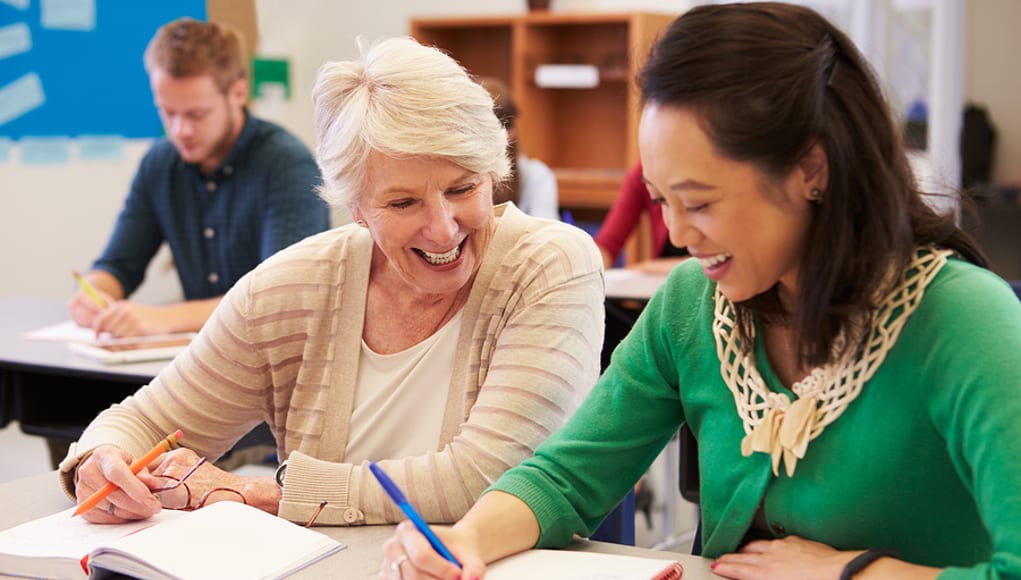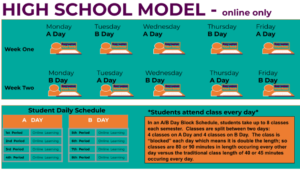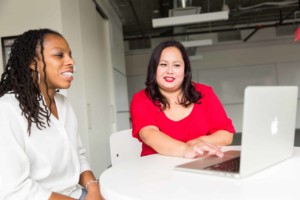Human Development as Professional Development: Fostering District-Wide Well Being

“I thought I was okay, but I wasn’t sleeping.”
“I’ve been lashing out at those around me.”
“I felt like I was handling things really well, but I didn’t realize I’d stopped smiling.”
“I had so much trouble saying goodbye to last year’s class because we were bonded in a way that only trauma can forge.”
These reflections were shared by educators and parents from Broward County, Florida this past summer. This was the first summer break following an unimaginable tragedy on Valentine’s Day of this year when seventeen students, teachers, and staff perished at the hands of a gunman at Marjory Stoneman Douglas High School (MSD). The teachers, students, administrators, support staff, and parents from MSD, and the broader Broward community, ended the school year with many layers of conflicting emotions: devastation, anger, sadness, uncertainty, distress. In short, the community was traumatized. As an educator from MSD noted about the broader district, “Every person attached to a child or a school in our vicinity experienced a trauma. Not only at Stoneman Douglas, but at other schools, too, as this made everyone realize that this kind of tragedy could happen to you.”
In the wake of this kind of collective trauma, how does a school district systematically support all the various individual experiences and reactions? How does any public agency, which has a dedicated purpose, respond to a transcendent, all-encompassing community need? This tragedy happened in a school–an institution of public investment in the future. How does a school system begin to focus on reading, writing, and arithmetic, when a fourth “R” of recovery predominates?
A Different Kind of Professional Development
Traditional professional trainings and support for educators do not include efforts that address the human impact of loss, grieving, trauma, stress, and the search for meaning after this kind of event. Working on one’s own mind and body to support a community’s health and safety is a different form of learning than an educator’s usual summer options of standards, instructional materials, and pedagogy or the emergency management trainings covering See Something, Say Something, CPR, and Code Red drills. Most districts are not equipped with this kind of expertise. And, this work is difficult to mandate to success.
In speaking with other communities that have been impacted by school shooting tragedies, Broward district personnel were reminded that sustained efforts to heal would be required. This effort would need to sew together resources from the immediate community, the broader regional community, and national resources and expertise. Enter the Center for Mind-Body Medicine.
The Center for Mind-Body Medicine
The Center for Mind-Body Medicine (CMBM) works with individuals who are frontline community service providers–those people in a community that help to take care of the community. They describe their work as follows: “We train local healthcare providers, educators, and community leaders to teach children and adults simple, powerful self-care techniques that help relieve their stress and trauma. We help people and communities heal.”
Their model is based on self-care of the service providers, by the service providers. The logic model is straightforward-–self-care cannot be given by those in duress, and healing is best promoted by those that are healing themselves. It is straightforward, but not simple. Self-care has historically not been a field that has scientific studies and technical expertise as an underpinning. CMBM has brought the discipline of modern medicine and techniques from healing traditions to establish “the world’s largest, most effective evidence-based program for healing population-wide psychological trauma and stress.”
The CMBM was created and has been led by James S. Gordon, MD since 1991. He is a Clinical Professor of Psychiatry and Family Medicine at Georgetown Medical School. The CMBM works both extensively in the United States and globally. Domestic projects have included working with communities that have experienced loss from natural disasters (post-Katrina New Orleans, post-Harvey Houston, post-Sandy NJ-NY-CT, post-fire Sonoma County), protracted and systemic trauma (the Pine Ridge and Standing Rock Reservations, veterans of the Iraq and Afghanistan wars and their families), and the senseless occurance of school shootings.
To establish the importance of this kind of training and to maximize participation in this work, educators received compensation and professional development learning credits for initial or recertification. Broward County Public Schools covered these costs. Support from the Chan Zuckerberg Initiative (CZI) provided the funding to bring CMBM faculty and services to Broward for three phases of work:
- The first ten weeks after the tragedy focused on bringing together school and community members in the Spring of 2018;
- Trainings for school and community members in initial CMBM and advanced CMBM work during July of 2018; and
- Working with the teachers, administrators, and other staff at MSD and the feeder middle school that is co-located on the same property during the week before students returned in August of 2018.
Self-Care Strategies for Educators & Students
The cornerstone of the CMBM approach is that “self-care isn’t complementary or alternative — it’s fundamental for good health.” Their work and trainings focus on teaching participants strategies and techniques to first, help themselves engage in their own self-care, and then, in turn, teach peers and students how to engage in these kinds of behaviors. This approach begins by acknowledging that thoughts and emotions occur within the body, in all people. There are connections between how the body functions, what we feel, and how we think, that involve numerous physiological feedback loops. By intentionally settling the mind to relax the body, emotions are allowed to occur and dissipate.
The strategies are simple and research-based. Nancy Romer, a Broward County elementary teacher, described the program: “CMBM gave us a toolbox of many strategies to deal with our past pain, ward of new ones, or deal with them if we cannot avoid them. It was affirming that research and medical practice have shown the benefits of shaking, dancing, breathing meditation, yoga, and mindfulness to our overall physical and emotional health–and that we can bring those benefits to our students.” Some of these strategies and techniques include:
- Small Group Sharing: Stress and trauma can often leave a person feeling isolated with their emotions and responses. By creating a small group of 10 to 15 individuals who can share experiences, responses, and feelings, participants feel connected and supported. The leader, who is also a group participant, establishes that the group is a safe and trusting environment. One teacher reflecting on her own small group experience explained that “It is a wonderful tool to help us deal with what we have to deal with. We realized we’re all in this together. We can lean on each other.” Another observed that this helps students know and understand that “they are not alone in what they are feeling.”
- Soft Belly Breathing: This is simply slow, deep breathing, in through the nose, out through the mouth, with your belly relaxed. This kind of breathing quiets the mind, and allows individuals who feel stressed or overwhelmed the ability to feel calm, to connect with others around them more easily, and to be more present. One educator who participated noted: “I now breathe differently. When things get stressful, I slow it down and find that space to breathe.”
- Imagery: Participants, whether students or adults, are encouraged to imagine a safe or special place, real or imagined, where they feel comfortable. They are encouraged to breathe deeply as they are prompted to imagine and note various details (e.g., what are they wearing; sounds they might hear; how old they are; the temperature; and whether anyone else is there) as they think about this setting. This practice fosters relaxation, reduces stress and anxiety, and provides an emotional “safety net” for them to retreat to when they feel stress or anxiety.
- Movement, Dance, & Shaking: Movement–including dancing and shaking–releases tension, raises energy, and disrupts physical and emotional states in which one may be stuck. Participants are encouraged to move and dance to music in whatever way feels right for them. A teacher from MSD noted that “Every school day should start with dancing and movement. It doesn’t take long and gets things going, allowing kids to move pent up energy out of their bodies.”
- Meditative Practices: There are a wide variety of meditative practices that have emerged in cultures around the world. Western traditions often associate these behaviors with religious practice. Embracing the medical benefits of meditation, CMBM encourages mindfulness as a practice, and invites participants to draw on a tradition of meaning to them, or to develop their own meditative practice. A student participant from Marjory Stoneman Douglas High School stated, “This experience made me feel liberated from my worry. It allowed me to focus on the present.” An educator from the school summed up the effect nicely, “This is all helping me get back to me.”
On-Going Self-Care: Fundamental for ALL Educators, Students, & Families
Though much of their work centers around trauma and disaster response, CMBM sees their mission as universal. They, and many of those who have undergone their training, agree that all students, teachers, and families can benefit from learning and practicing these behaviors of self-care. When Dr. Gordon founded the organization nearly three decades ago, his vision was to make “self-awareness, self-care, and group support central to all healthcare, the training of all healthcare professionals, and the education of all our children.” He explains that the techniques and approaches CMBM teaches are really basic to how human beings function and interact: “This should be in every school. This is fundamental, not alternative or complementary.”
This training and the utilization of these strategies should be common practice, proactive, and ongoing if schools are going to address whole child and comprehensive adult development. Educating students, teachers, and parents on how to understand their emotional responses to life events, and how to productively cope with those emotions, can both prevent crisis and promote healthy development. Amy Kenny, an educator and yoga teacher who brought a full-time yoga program to Marjory Stoneman Douglas High School two years ago, explains: “There are many levels to trauma and stress. There are stress and trauma in homes, in schools, and in neighborhoods. All of us have some degree of trauma and stress, whether it’s big or small. If there were a way that every student could work through and understand stress and trauma, from as young as preschool, and learn the skills to productively process it so it doesn’t build up, continue, or progress, then it would never duplicate. Imagine what a healthier society we would live in.” This course offering has grown to enroll over 300 MSD students taking yoga and mindfulness each semester as an elective PE credit. By utilizing the techniques and strategies learned in these courses, many of the students have reported lower levels of anxiety and improved stress management, both before and after the shooting.
And to maximize these kinds of benefits, buy-in and practice of self-care behaviors must be systemic. Gordon explains, “Where we’ve had the greatest success in our work is where we’ve been able to work with everyone in an institution–all the teachers, staff, kids, and parents–the whole community. Everyone is then creating this opportunity for being yourself, and for using techniques for dealing with stress.”
This can be most difficult for teachers, themselves. Teachers, as a group, spend their days thinking about and helping others–their students. Focusing on oneself can feel selfish or frivolous. A Broward County educator who completed the CMBM training was astonished to realize, “I’ve been an educator for more than two decades, but this is the first time I’m focusing on me and my own self-care. I didn’t realize I needed to.” It should not require an intense trauma to facilitate self-care. CMBM emphasizes, though, that self-care is not a skill you can teach unless you are also engaging in it yourself. One teacher noted, “I realized I need to make sure I’m okay before I can be there for my students.” And this is true for all educators and must be regularly re-visited.
Looking Forward
The tragedy that happened in Parkland, FL this past February is horrific. But, survivors, and the broader community, are striving to make meaning of their response to the tragedy. For some, the meaning is an attempt to return to their routines from a world prior to the shooting. And others are working to improve the quality of how they live today. CMBM is helping people be calmer, grounded, and more mindful individuals. CMBM is providing tools, behaviors, and habits for participants who want to turn aspiration into living–who want to live as the kind of person they wished lived in the world. They are sharing tools that all people can use to be healthier and happier.
Teacher Nancy Romer connected the experience to outcomes most educators strive for every day: “I think that if we can incorporate these strategies into our teaching day, we will see better behavior in our classrooms, happier kids, higher academic achievement, and overall healthier communities.” Broward County Public Schools and CMBM are providing professional development needed for teachers throughout the community to be most effective and students to maximize learning and healthy living–for a lifetime of productive human development. They are aiming to be a model for all districts; not just those healing from tragedy.
For more, see:
- In Broward County, Student Voice Impacts the Classroom and Beyond
- Addressing the Hidden Effects of Trauma in a School Community
Stay in-the-know with all things edtech and innovations in learning by signing up to receive our weekly newsletter, Smart Update.







0 Comments
Leave a Comment
Your email address will not be published. All fields are required.